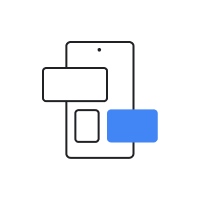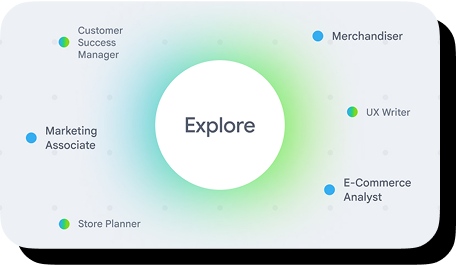
What is UX design?

Fundamental principles of UX design
To better understand what design is, it's helpful to compare it to art. While both require creativity and vision, art often focuses on self-expression, whereas design is inherently about solving problems in an elegant, user-centric way. This core distinction means that UX design, in particular, is governed by objective principles that guide designers in creating clear, functional experiences that effectively serve users.
Some key UX design principles include:
User-centricity
User-centric design ensures a product or service is intuitive and simple to use, minimizing user confusion and frustration. By prioritizing clarity, designers help users achieve their goals efficiently—whether completing a task, accessing information, or navigating an interface.
Building for everyone
When being user-centric, it’s important to also consider how different one user may be from another. Taking into consideration a wide array of personas, experience levels, and technical aptitude will allow designers to better reflect the people who may use their products. This principle encourages designers to help create experiences that work for everyone.
Enjoyment
Enjoyment emphasizes creating positive emotional experiences for users. By designing interfaces that are visually appealing, engaging, and satisfying to use, UX designers foster a sense of delight and connection during key interactions.
Usefulness
Usefulness highlights the importance of solving real problems or specific needs for the intended audience. Designers focus on understanding user goals and challenges to deliver solutions that provide meaningful value.
The UX design process
The UX design process is a structured approach to creating user-focused solutions. This process is built to ensure that every decision is aligned with user needs and expectations, while resolving key challenges. The four main stages of the process are:
1. Understand
"Form follows function" is a core concept in design, emphasizing that a product's purpose should dictate its shape and features. Before making design choices, it's crucial to understand how users experience the product by thinking from their perspective. At this stage, UX designers conduct user experience research that helps inform design decisions, improve usability, and create satisfying experiences. Research methods may include interviews, surveys, usability testing, data analysis, and more.
2. Specify
Once you understand your user, you can specify which of their needs, problems, and pain points your design should address, using a clear problem statement. A well-defined problem statement helps establish clear goals, define your deliverables, and create benchmarks for success. Additionally, it fosters team alignment by ensuring everyone has a shared understanding of the user problem that needs to be addressed.
3. Design
With a firm understanding of your users and a defined problem to solve, the hands-on design work begins. This stage focuses on generating ideas and developing the product's design. The design phase can be broken down into four parts:
- Ideation: Teams brainstorm a variety of ideas for how the product might look and function. The goal is to explore creative possibilities and identify fresh, practical, approaches to solving the identified user challenges.
- Wireframing: Wireframes serve as the skeletal framework of the product, outlining layouts and interactions. They help visualize how elements fit together and guide the user flow with the help of blocky interface sketches.
- Prototyping: Prototypes are simplified versions of the product that showcase its core features and functionalities. They allow teams to test concepts, gather feedback, and refine designs before moving forward.
- Visual design: In the visual design stage, UX experts focus on the product’s aesthetic appeal while supporting usability. Elements like color palettes, typography, icons, and overall style are carefully crafted to create an interface that is both engaging and intuitive.
4. Evaluate
The evaluation stage assesses how successfully your design serves the user and addresses the problem statement defined earlier in the UX design process. This is done by weighing your product against the previously outlined core UX design principles of usability, building for everyone, enjoyment, usefulness, and user-centricity.
This stage is critical for identifying any remaining pain points or unaddressed user requirements. Feedback gathered during evaluation allows teams to make final adjustments before the product is finalized and launched.
UX strategy: Aligning design with business goals
While UX design is deeply rooted in understanding and serving users, effective design doesn't exist in a vacuum. It's also about achieving tangible outcomes for businesses. This is where UX strategy comes into play – it's what ensures every design decision not only meets user needs but also directly supports a company's broader business objectives.
A well-crafted UX strategy balances what users want and need with what the business aims to achieve. It goes beyond simply making a product look good or function smoothly; it ensures that the experience contributes to core business goals like increasing sales, improving customer retention, or reducing support costs. This strategic alignment helps companies build products that are both desirable to users and profitable for the organization.
Key elements that inform a good UX strategy include:
- Business Goals: Clearly defined objectives for what the company wants to accomplish (e.g., expanding into new markets, enhancing brand loyalty, or increasing market share)
- User Needs: A deep understanding of the target audience, their pain points, behaviors, and aspirations, uncovered through dedicated research.
- Competitive Landscape: Analysis of competitors’ strengths and weaknesses in their user experience, identifying opportunities for differentiation and innovation.
- Success Metrics (KPIs): Measurable indicators that track whether the design is achieving its intended business and user outcomes (e.g., conversion rates, user engagement time, or customer satisfaction scores).
By integrating these elements, a UX strategy provides a clear roadmap for design efforts. It ensures consistency across all user touchpoints and helps teams make informed, data-driven decisions that propel both user satisfaction and business success. Without a clear strategy, even the most beautiful design might miss its mark in the marketplace.
Core skills for UX designers
Becoming an effective UX designer means mastering a blend of technical, research, and interpersonal skills. These skills shape how you approach problem-solving, how you collaborate with teams, and how you advocate for users throughout the design process.
Technical skills
Technical skills enable designers to transform ideas into functional and visually engaging products. These skills cover proficiency with specialized tools, creating foundational design elements and applying principles that enhance usability and aesthetics. Some core technical UX design skills to master are:
- Proficiency with industry-standard software and applications for crafting interfaces and managing collaborative design products.
- The ability to create effective wireframes and prototypes to visualize concepts and test functionality before design and development.
- An understanding of visual design principles to ensure layouts are attractive and intuitive for users.
Research skills
Effective UX design relies heavily on understanding user needs and behaviors, making user experience research foundational to the UX design process. Key research skills include:
- Conducting user research to uncover pain points and user preferences.
- Analyzing and synthesizing research results to identify patterns and inform design decisions.
- Planning and conducting usability studies to evaluate how users interact with prototypes or finished products.
Soft skills
In addition to technical and research skills, UX designers use a variety of soft skills to effectively understand their users, navigate design challenges, and collaborate effectively with other team members. Some of the most important soft skills are:
- Empathy for different user perspectives and a passion for designing solutions that meet their needs.
- Effective collaboration for working with cross-functional teams, including developers, marketers, and key stakeholders.
- Communication skills to articulate design choices and share ideas clearly with team members and clients.
- Problem-solving to address unexpected challenges and refine design iterations.
- Time management to prioritize tasks and meet deadlines in fast-paced environments.
The role of user experience research
To design a great product, you first need to understand the people who will use it. That understanding comes from User Experience (UX) research: the process of learning about users' behaviors, needs, and motivations to guide design decisions. It’s how designers ensure a product is not just attractive, but genuinely useful and easy to navigate.
The primary goal of UX research is to replace assumptions with real-world evidence. By engaging directly with users, designers gain a deep sense of empathy for their perspectives, motivations, and frustrations. This empathy is crucial because it allows designers to identify real problems and design solutions that genuinely resonate with user needs.
Research isn’t a one-and-done step; it’s a cycle that continues throughout a project:
- Before Designing (Discovery Research): This phase focuses on understanding the problem space and the target users. Methods like interviews and surveys help uncover user needs, behaviors, and pain points before any design work begins.
- During Design (Evaluative Research): As prototypes and designs are developed, research methods like usability testing are employed to evaluate how users interact with the product. This helps identify issues early on and gather feedback for iterative improvements.
- After Launch (Post-Launch Research): Once a product is live, ongoing research using analytics tools or experiments can help measure success, identify areas for further improvement, and understand long-term user behavior.
UX research can be broadly categorized into two main types:
- Qualitative Research: Focuses on understanding the "why" behind user actions and experiences. This involves direct observation and interaction, such as one-on-one user interviews or field studies, to uncover rich, descriptive insights.
- Quantitative Research: Focuses on measurable data to understand the "what" and "how many." This involves collecting numerical data through methods like large-scale surveys, analytics data, or A/B tests to identify patterns and trends across larger user groups.
Ultimately, the role of UX research is to reduce the risk of designing a poor user experience. By compiling comprehensive insights into user needs and behaviors, companies can avoid building products that no one wants or needs, saving valuable time, resources, and ensuring the final product makes a positive impact.
Crafting a UX design portfolio
As a designer, your portfolio is your most powerful tool for showcasing your skills, process, and unique perspective. For those new to UX design, the idea of creating one might seem daunting, but it's an essential step.
Your portfolio is more than a simple collection of work — it’s a chance to stand out in front of recruiters and hiring managers. Through programs like the Google UX Design Certificate, you'll be guided step-by-step through the creation of a portfolio that highlights your job-ready skills.
Here are some of the most impactful elements of strong UX design portfolios:
Curated work
Your portfolio should feature your best projects, carefully selected to demonstrate your strengths as a designer. Focus on quality over quantity, including projects that highlight different aspects of your expertise, such as wireframing, prototyping, or visual design.
Personal branding
Use your portfolio to communicate who you are as a designer. This includes showcasing your unique style, values, and the projects that excite you. These considerations can help recruiters see what sets you apart.
Storytelling through case studies
Engage your audience by presenting case studies for each project. Walk them through your design process step-by-step, from identifying the problem to delivering the final solution. Highlight key insights, challenges, and successes along the way to demonstrate your ability to think critically and solve real-world problems.
Simplicity and clarity
Keep your portfolio concise and easy to navigate. Use minimal text to describe your work; focusing on main takeaways rather than lengthy explanations. Simple navigation helps users easily explore your project and find important pages, such as your contact information.
Responsive design
Make sure your portfolio is optimized for all current devices. A responsive design ensures your work looks polished and professional no matter how someone views it. Test your site across multiple devices to catch any issues before sharing it with recruiters.
Why is UX design important?
Good design is functional and intuitive, removing obstacles and reducing friction between people and their goals. This user-friendly focus is central to UX design, which seeks to improve our relationship with the tools and technologies that make up our world. For businesses, creating better experiences for their customers can translate to a competitive advantage. When interactions are seamless and enjoyable, customers are more likely to come back, meaning better UX often makes for better business outcomes.
Learn more
UX design isn’t just about making things look good. It's about creating meaningful experiences that resonate with users and drive results for businesses. With more people than ever relying on websites and apps for their daily routines, good UX design makes technology more effective and easier to use.
If you’re considering a career in UX design, the Google UX Design Certificate can help you build the skills and knowledge to directly impact how people interact with technology. Whether you’re designing an app, improving a website, or streamlining a workflow, UX design offers a practical, rewarding path for problem-solvers who want to make technology work better for everyone.






